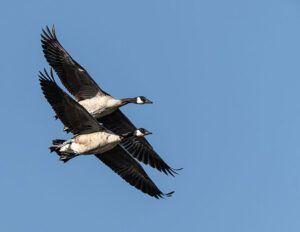 Fall outlook is a mixed bag of factors from weather to wildfire.
Fall outlook is a mixed bag of factors from weather to wildfire.
By Jim Yuskavitch, for Oregon Hunter magazine
Every upland game bird and waterfowl hunter knows the main force that affects hunting prospects from season to season — the weather. How harsh the previous winter was that affects overwinter survival, how cold and wet spring conditions were that can suppress the hatch, and how strong the spring green-up is that provides food for young birds. And for migrating waterfowl, the weather, as well – if nesting conditions were favorable in Oregon or up north, and when the winter storms come that drive the migrants south.
But there are other big-picture and long-term factors that play a key role in the health of Oregon’s game bird populations and how upland bird and waterfowl hunting opportunities will fare over time. Ongoing harvest success rates, climate and weather patterns, and wildfire are just some of the factors to be considered. The following takes a look at these indicators, based on the most recent data provided to the Oregon Fish and Wildlife Commission to offer insights to the longer trends for Oregon’s game bird populations and hunting success.
Upland Birds
Hunting success for a season is largely dependent on spring weather conditions, because most upland birds harvested were hatched that year. A cold, wet spring subjects young upland game bird broods to increased risk of hypothermia, while a spring just wet enough to produce a strong green-up will produce abundant food for the chicks, increasing their survival and growth rate. However, even after poor years, upland birds tend to bounce back quickly, and when hunting for a certain game bird species is poor, hunting pressure tends to drop, which also helps the population recover.
The U.S. Natural Resources Conservation Service recorded Oregon rainfall in May and June – the peak upland bird nesting season – at a little below the historical median. Some southeast Oregon counties were an exception with rainfall above median. However, that may end up being good, as it could possibly break the long-standing drought that part of the state has been experiencing – at least temporarily. Earlier this spring, Hines-based ODFW wildlife biologist Lee Foster noted that the High Desert region was wetter than it has been in some time.
Some historical data prove interesting insights. Oregon upland game bird numbers hit a high in 2005, then began to drop in 2007, mostly due to drought, with valley quail and chukar taking the biggest hits. The following near-decade of drought along with a hard winter in 2016-17 knocked down populations even more. Hunter harvest of all upland game birds during that period dropped from around 650,000 to about 200,000 most recently.
According to the most recent ODFW data, the 2022-23 upland bird harvest increased from the five-year average – with a couple of exceptions. At 29,237, the ruffed grouse harvest for 2022-23 was down 7 percent from the five-year average of 31,363. The ringed-necked pheasant harvest was down 25 percent from the five-year average with just 9,773 birds harvested.
Once arguably Oregon’s premier upland game bird, ring-necked pheasants have been the victim of human growth and development, especially in their former Willamette Valley stronghold, along with more efficient farming methods. Even in some of Oregon’s remaining wild pheasant regions, such as the Vale-Nyssa area of Malheur County, local ODFW District Wildlife Biologist Phillip Milburn notes that modern farming practices that leave less edge habitat and less winter stubble are taking a toll on the birds. Currently, private pheasant preserves and the ODFW fee pheasant hunts that are held at Fern Ridge, Sauvie Island, Denman and E.E. Wilson wildlife areas offer long-tail hunters the best bet these days.
However, there are plenty of positive indicators for Oregon upland game bird long-term trends. Harvest of sooty grouse, mountain quail, valley quail, chukar and Hungarian partridge were all above the five-year average – some substantially. Mountain quail was 130 percent above the five-year average, 56 percent for valley quail, 21 percent for sooty grouse, 199 percent for Hungarian partridge and 92 percent for chukar. At 64,359, chukar was the most harvested bird during Oregon’s 2022-23 season, followed by valley quail at 40,906. These were the two species hardest hit during the overall decline of Oregon upland birds beginning in 2008, perhaps indicating a slow but steady comeback. Wild turkey spring hunt tags were down by 39 percent but up 129 percent for the fall hunt. Total turkeys harvested for the spring 2022 and fall 2022-23 was 5,811.
Due to the sensitivity of the population, greater sage-grouse are monitored by ODFW and other government agencies more closely than other upland game birds. In 2015, the U.S. Fish and Wildlife Service determined that sage grouse were not warranted for listing under the federal Endangered Species Act because of the extensive conservation efforts across its range.
The most recent survey data shows that Oregon’s sage-grouse spring breeding population has increased by nearly 10 percent to about 17,508. Their numbers are up by 6.3 percent in the Prineville BLM District, up 1.8 percent in the Burns District, up 36.1 percent in the Vale District, but down 9.5 percent in the Lakeview District. While the overall increase is good news, it is still the seventh lowest population level counted since 1980, and well below the 1990 high of about 45,000.
For this reason, sage-grouse hunting is carefully controlled. The 2022 harvest was 370 birds. ODFW limits the harvest of sage-grouse to less than 5 percent of the fall population, which has no negative impact on their long-term numbers.
Wildfire
Increasing wildfires have become a fact of life in Oregon, and while very hot-burning fires that sterilize the soil can be highly detrimental to game birds, as some big High Desert fires have been for sage-grouse, they are a form of environmental disturbance that is beneficial over the long-term. Research has shown that, like deer and elk, game birds and other bird species also benefit from the grasses, shrubs and small trees that sprout after a wildfire, or a clearcut.
Migratory Birds
Doves & Band-Tailed Pigeons
To help estimate mourning dove populations, ODFW has been banding them since 2008, with 701 doves banded statewide last year. The total mourning dove population estimate by the U.S. Fish and Wildlife Service for the Western Management Unit (California, Oregon, Washington, Idaho, Nevada, Arizona and Utah) was 45,756,145 in August 2021 – up 43 percent from the previous year. Band-tail pigeon populations continue to hold steady over recent years.
Ducks & Geese
ODFW conducts resident breeding waterfowl surveys each year, concentrating on Oregon’s major breeding habitat locations. These include the Willamette Valley, and wetland areas in the Malheur Lake/Burns area, Warner and Catlow valleys, the Klamath region and a few other eastern Oregon locations.
The most recently compiled data shows Oregon’s breeding duck population up 32 percent at 344,558, with mallards, at 79,388, being the most common nesters in the state. The Oregon mallard breeding population is up 4 percent, but down 12 percent for the long-term average. The most recent recorded high for Oregon breeding ducks was in 1997 with a little over 350,000 estimated. So current numbers are approaching that former high. The lowest count was in 2011 at just a little over 150,000.
The 2021-22 mallard harvest was 135,613, a 9-percent increase over the five-year average. The next most harvested duck was American wigeon at 78,223, a 23-percent increase from the five-year average, followed by green-winged teal at 59,434, representing a 13-percent increase from the five-year average. The total duck harvest for that season is estimated at 385,101 – which includes migrants.
Northern pintails have continued to decline. The estimated northern pintail population for the entire continent is 1,782,800 – down 21 percent from 2019 and 54 percent from the long-term average. Pintail numbers have been declining since the 1950s. Much of this can be attributed to long-term drought conditions in the Canadian prairie provinces. Northern pintails are also known to move further north in search of better nesting habitat as drought conditions worsen, and some waterfowl managers have theorized that the birds could be moving out of established survey areas and may be undercounted. However, for now that’s an unproven hypothesis.
For the 2023 breeding season, Ducks Unlimited’s report for western Canada is favorable in most of British Columbia, with a near-average snowpack to replenish wetlands, while the Canadian prairie “pothole” provinces were a little dryer than normal. Most of Oregon’s fall migrant ducks come from Alberta, British Columbia and Alaska. Alaska tends to be a regular strong provider of fall migrants.
Oregon has several species of geese, although only the Pacific western Canada goose species nests here. In 2021, Pacific western Canada goose numbers were 53,795, a 13-percent increase from 2019. Along the Pacific Flyway, the Pacific western goose population is estimated to be 347,000 – well above the 119,000 management objective. Based on surveys in Alaska’s Yukon-Kuskokwim delta, Pacific white-fronted geese breeding populations are at highs, while minima cackling geese are below management objectives. Dusky Canada geese surveyed in Alaska’s Copper River Delta were also down, but close to the long-term average. Recent snow goose counts on Wrangell Island put their numbers at a record high of 706,068, also well above the objective of 200,000.
A total of 63,069 geese were harvested during the 2021-22 Oregon goose season, including 49,179 Canada geese, up 9 percent from the long-term average, and 7,438 snow geese, up 47 percent.
Duck Season Date Changes
The 2023-24 duck season will be affected by changes in the big game seasons. According to the ODFW big game management framework, the any-legal-weapon buck season begins on the first Saturday of October. It’s a key season opening date because other season starts are coordinated to this opener. This year, when the first Saturday of October falls on the 7th, which is the latest possible opening date for this hunt under the framework, the opening day jumps a week later. Then the opener for this and most other big game seasons will be a day earlier each year until it is time to reset once again.
Federal migratory waterfowl hunting rules limit the duck hunting season to 107 days between the Saturday closest to Sept. 24, and ending by Jan. 31. Taking into account special hunt days for youth, veterans and military personnel, the general duck season will run for 104 days. Typically the Zone 2 duck season opens and closes a week earlier than the Zone 1 season to allow eastern Oregon hunters more freeze-free days of hunting. Because the duck opener is timed to the week after the buck deer opener, both Zone 1 and Zone 2 will open and close at the same time – Oct. 14 to Jan. 28 – to maintain the full allowable hunting days in each zone.
